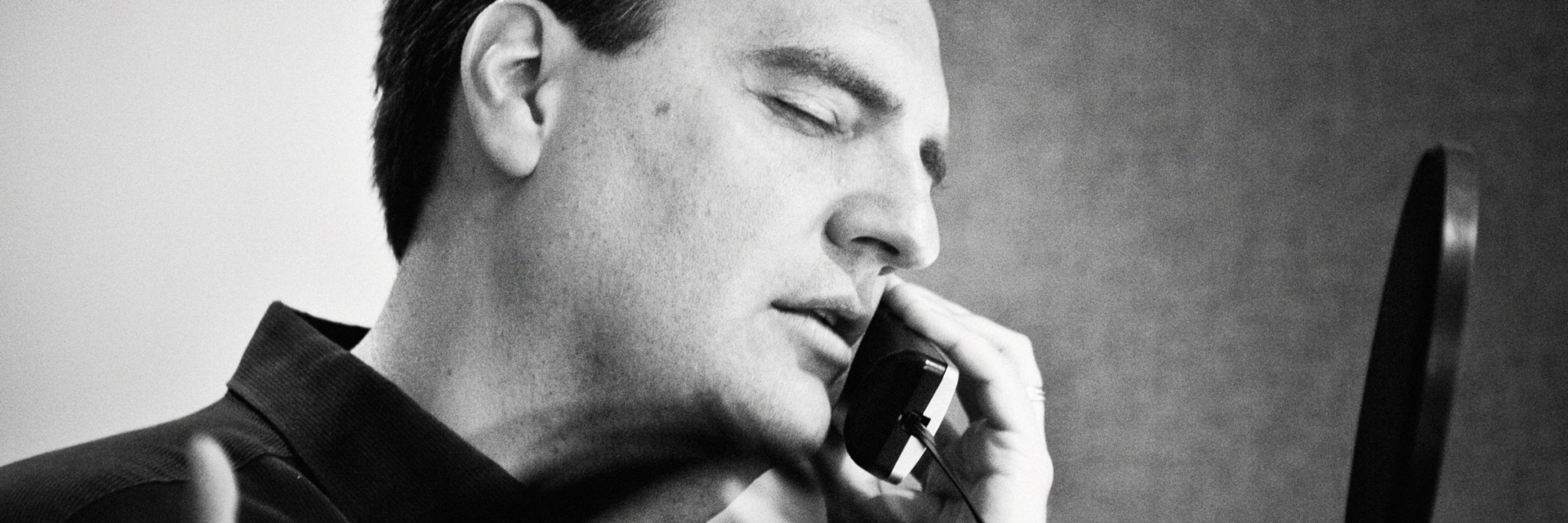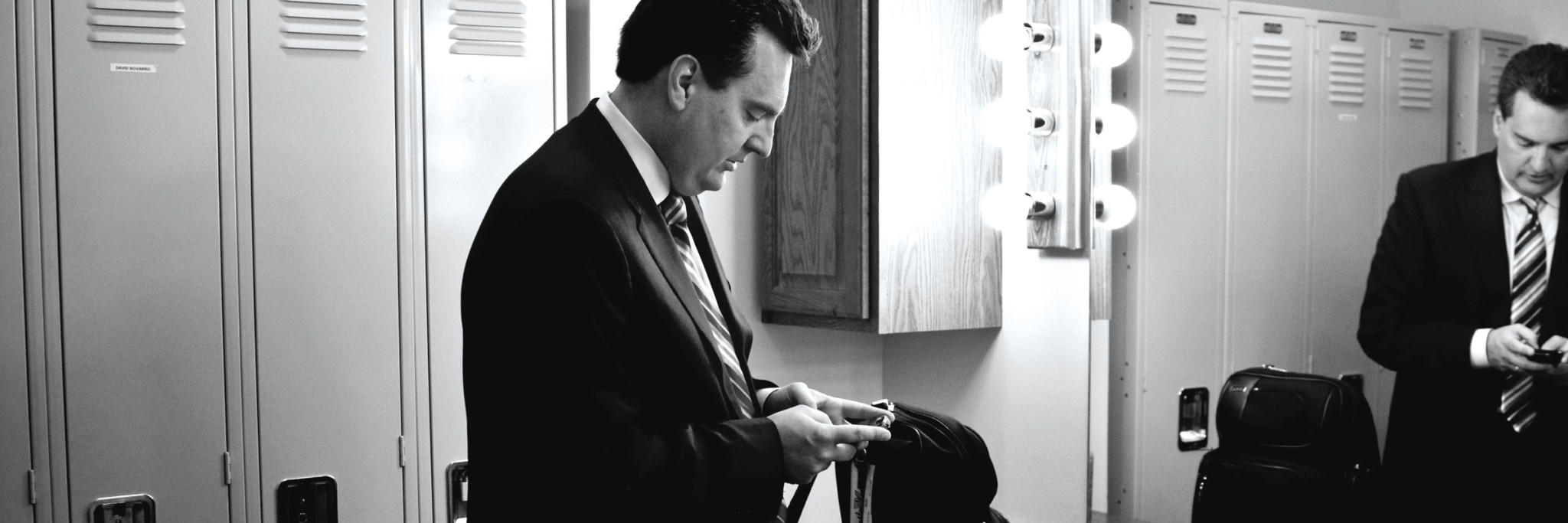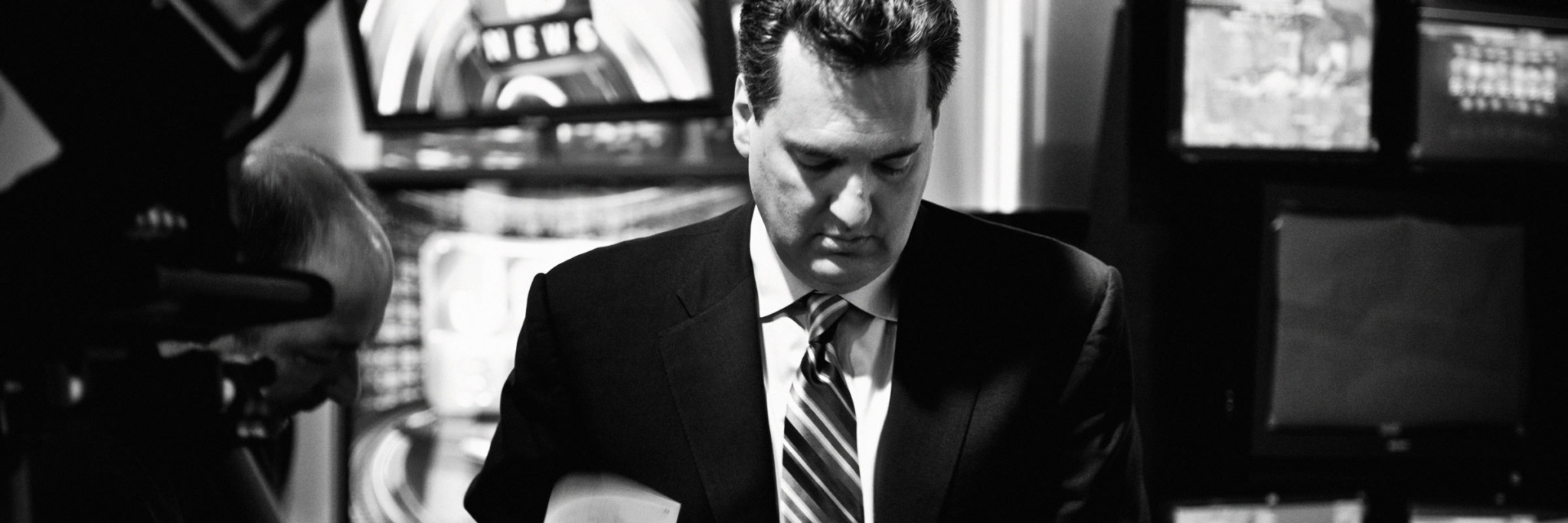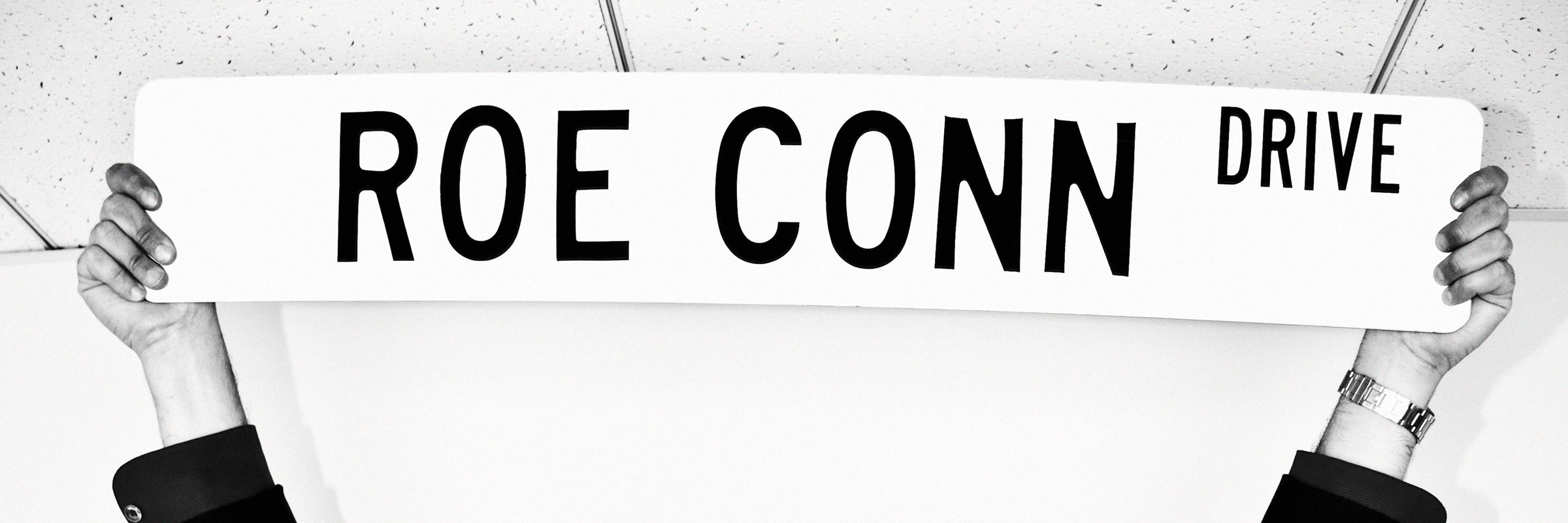It’s 1:25 p.m., just 35 minutes before the start of the Roe Conn show with Richard Roeper, a four-hour drive-time talk-radio show, and Roe Conn himself still needs to tape an interview with the comedian and actor Billy Gardell. At the moment, though, he can’t quite remember who Gardell is, let alone why he should be talking to him.
“I know I’ve interviewed him before, but I just can’t place him,” Conn says as he rides the elevator to the station’s ninth-floor offices in the Chicago Loop–his voice low, just in case Gardell is standing next to him.
He isn’t. And by the time Conn reaches the small studio, his executive producer, Jock Hedblade, is in tow, filling in the blanks.
“His thing is, he’s got a sitcom coming out, Mike and Molly,” says Hedblade. Seeing the two of them side by side–Hedblade, a trim and compact man, whose outfit for the day includes furry leather boots and a straw hat, and Conn, tall and clean-shaven in a dark dress shirt and jeans, his thick black hair starting to show a touch of grey–one might easily mistake Hedblade for the talent and Conn for the producer. (Conn did, in fact, produce shows for both TV and radio in Chicago before he began hosting weekends at WLS in 1989.)
“On CBS?” Conn asks, as the pair make their way into the booth.
“CBS.”
“Billy?” he whispers.
“Yeah, Billy.”
A few seconds later, Gardell walks in and heads straight for a microphone. In less than a minute, he and Conn are deep in conversation, sounding for all the world like old friends. “This is gonna be huge,” Conn says of Gardell’s impending sitcom, with genuine enthusiasm.
By 1:40 p.m, the interview has been taped, and Gardell is out the door. So is Conn. With 20 minutes to go until show time, he is constantly on the move, finalizing prep- arations for a telephone interview with Geraldo Rivera about Joran van der Sloot, the Dutch man who recently was accused of killing a Peruvian woman, five years to the day after he allegedly murdered an American one, and reviewing the latest edition of The Roe Report, a two-minute long, nationally syndicated radio segment that Conn introduced in 2009.
Produced by Conn’s own Skywave Entertainment, The Report is essentially a humorous synopsis of the day’s quirkier headlines, delivered by Conn against a rock ‘n’ roll soundtrack that he himself selects. (Conn got his start in radio his junior year at Denison, spinning records on Saturday nights at WDUB; as a kid, he made “mix tapes for girls” in the makeshift studio he built in his bedroom.) The Roe Report also is streamed online as a video piece, and Conn’s digital media producer, Adam Sobel, shows him this week’s finished product in a cluttered cubicle that does double duty as storage area for the Canarble Wagon, a cocktail cart that makes an on-air appearance every Friday afternoon. Several cases of Red Bull energy drinks line the walls, as well. “I mentioned Red Bull once on the air, and this is what they sent me,” Conn says.
The Canarble Wagon might be one of Conn’s signature bits on air, but the Red Bull is a more apt metaphor for the show itself: tart, sweet, and highly caffeinated; it goes down easy but packs a substantial wallop.
The Roe Conn Show with Richard Roeper (aka Roe & Roeper) offers a take on current events and popular culture that is sometimes incisive, sometimes satirical, and sometimes both. Conn and his on-air partner, the longtime Sun-Times columnist and film critic Richard Roeper, share a news junkie’s familiarity with the head- lines and an appreciation of the absurd; as a result, the tone of the show veers from the somber to the ridiculous, sometimes within the space of a few seconds.

By 1:40 p.m, the interview has been taped, and Gardell is out the door. So is Conn. With 20 minutes to go until show time, he is constantly on the move, finalizing prep- arations for a telephone interview with Geraldo Rivera about Joran van der Sloot, the Dutch man who recently was accused of killing a Peruvian woman, five years to the day after he allegedly murdered an American one, and reviewing the latest edition of The Roe Report, a two-minute long, nationally syndicated radio segment that Conn introduced in 2009.
Produced by Conn’s own Skywave Entertainment, The Report is essentially a humorous synopsis of the day’s quirkier headlines, delivered by Conn against a rock ‘n’ roll soundtrack that he himself selects. (Conn got his start in radio his junior year at Denison, spinning records on Saturday nights at WDUB; as a kid, he made “mix tapes for girls” in the makeshift studio he built in his bedroom.) The Roe Report also is streamed online as a video piece, and Conn’s digital media producer, Adam Sobel, shows him this week’s finished product in a cluttered cubicle that does double duty as storage area for the Canarble Wagon, a cocktail cart that makes an on-air appearance every Friday afternoon. Several cases of Red Bull energy drinks line the walls, as well. “I mentioned Red Bull once on the air, and this is what they sent me,” Conn says.
The Canarble Wagon might be one of Conn’s signature bits on air, but the Red Bull is a more apt metaphor for the show itself: tart, sweet, and highly caffeinated; it goes down easy but packs a substantial wallop.
The Roe Conn Show with Richard Roeper (aka Roe & Roeper) offers a take on current events and popular culture that is sometimes incisive, sometimes satirical, and sometimes both. Conn and his on-air partner, the longtime Sun-Times columnist and film critic Richard Roeper, share a news junkie’s familiarity with the head- lines and an appreciation of the absurd; as a result, the tone of the show veers from the somber to the ridiculous, sometimes within the space of a few seconds.
“I got it” is a common refrain from Conn, one that he frequently lobs through the control-room glass–as in, “I got that we have two minutes to tie up this segment on Internet porn before the next commercial,” or “I got that we’re so far behind, we only have 15 seconds for headlines.” He can sound curt, but he’s just being efficient, having adapted over many years to function in an environment where there is literally no time to waste, and that requires him to multitask for hours on end.
“Roe can process multiple voices in a way that most talk radio hosts can’t,” Sobel, the digital media producer, says. “He has that ‘soft focus’ that isn’t a natural human thing. He’s performing and managing the show at the same time.”
Conn, who grew up in Chicago, the son of a career Air Force officer, is occasionally accused in online forums of hogging airtime at the expense of those around him. In the studio, this does not appear to be the case; but it is certainly true that the man has a lot to say. Over a hurried pre-show lunch at Harry Caray’s Italian Steakhouse (he’s part owner of the chain’s tavern at Navy Pier) Conn moves easily from a disquisition on the city’s comic radio teams–the most famous being that of Steve Dahl and Garry Meier, followed closely by that of Meier and Conn himself–to a primer on its rich journalistic tradition, with references along the way to personal touchstones like Woody Allen and Mike Royko. Later that night, after a tour of the home recording studio where he assembles The Roe Report, he speaks just as fluently about immigration reform, continental versus Canadian French, and the indigenous tribes of the Pacific Northwest.
Conn himself has been the subject of much talk over the years, not all of it welcome. In 2004, after nearly nine highly rated years together, he and his former partner Garry Meier parted ways, with partisans of each man blaming the other for what turned out to be a very messy divorce. Then, in 2009, just as a weakening economy forced WLS’s owner, Citadel Broadcasting, into bankruptcy, station management began to claim that Conn’s ratings had softened, and initiated a bewildering series of personnel changes at the show. The appointment of conservative talker Cisco Cotto as co-host was particularly controversial, and was widely seen as an effort at skewing the show toward the station’s conservative base. (Conn contends that the ratings argument was misleading and based on a very selective reading of his numbers. He also has said publicly that Cotto was being groomed to replace him. Given the rightward-leaning tendencies of the station’s programming, this is plausible: Rush Limbaugh precedes Conn, while Sean Hannity follows him.)

Once today’s show gets its start, Conn takes calls in WLS’s main studio about a Chicago police officer accused of killing two people in a drunk-driving crash, only to follow up with an extended riff on the news that Elmhurst, Ill., had just been named the “Internet porn-seeking capital of the United States.” And the conversation with Rivera about van der Sloot, though largely consumed by the facts of the case, was followed by some merciless ragging on Rivera himself, who described the accused in typically purple (and biased) prose as “a perverted colossus.”
Roeper: ‘A perverted colossus’ … only Geraldo …
Conn: Some people on the text lines are already saying, ‘What happened to journalistic ethics?’ Geraldo? A journalist? When did that happen?
Roeper: I won’t even talk to [former Saturday Night Live impressionist] Darrell Hammond when he’s imitating Geraldo. That’s how–
Conn: –that’s how bad that is?
Roeper: Just kidding.
Conn: I’m going to set up a beer summit with you and Geraldo. Maybe Joe Biden’ll stop by. He likes to go to those things.
For the most part, however, Conn, who has been one of the top-rated radio hosts in Chicago for nearly 20 years, with a sideline in television (he’s a regular commentator for Fox News-Chicago), is less a purveyor of parody than he is an ironic commentator on the events of the day–more Mort Sahl, say, than Jon Stewart. And the pace of his weekday program, which seems brisk enough on air–the show bounces back and forth between interviews with celebrity guests and call-in segments, news reports and ads–can be absolutely frenetic behind the scenes.
Radio ratings are a big deal in the business because that’s how stations sell programs to advertisers. Traditionally they have been compiled by having listeners keep logs. But increasingly stations now rely on Portable People Meters, pager-like devices that use encoded signals to determine precisely what listeners are tuning in at any given moment. By eliminating the fuzziness inherent to listening logs–according to Conn, people exaggerate the time they spend listening to shows they like, and ignore time spent listening to ones they don’t–these electronic devices have made advertisers, and therefore stations, and so, radio personalities, pay even closer attention to the production values than they have in the past. And that has lent an urgency bordering on desperation to the task of keeping listeners glued to their radios. “It’s always been important, but now it’s imperative,” says Conn. The constant pressure to “push” an invisible cohort of listeners from one quarter hour to the next, and to keep them listening for at least five minutes out of every 15 so that they will be counted for ratings purposes, heightens the time sensitivity of the studio environment, an environment that is already ruled by the tyranny of the clock. Even when the national and local news spots are playing, Conn must periodically jam on his headphones, grab his microphone by its spring-loaded boom, and quickly intone a “teaser” in between segments–one designed to keep listeners tuned in for the next few minutes. Once done, he hurls the mic back out of his face like a quarterback throwing a Hail Mary pass.
During the show, Conn might give the impression that he is just casually cracking wise with Roeper and the rest of his crew, but he is cognizant at all times of the sweeping second hand, of the approaching four-minute news update or 30-second commercial spot or eight-minute prerecorded interview. He must split his attention between what he is hearing and saying in the moment, what his producer is whispering in his headphones, and what he is reading on the various computer monitors arrayed before him: the news feed and show schedule, the text messages submitted by countless listeners, the previews of incoming calls. And he cannot lose focus or let his intensity flag for even a moment; this is not some barroom conversation with friends, but a performance paid for by advertisers seeking access to an audience of 800,000 people in seven states, with an additional 150,000 listening online.


It didn't work–perhaps because Conn, despite having filled in for the provocative right-wing commentator Glenn Beck on CNN, is not particularly ideological. In a commercial talk-radio landscape that has become increasingly polarized along political lines, Conn is an outlier: an equal-opportunity gadfly who skewers both liberals and conservatives with abandon. "Traditional talk radio deconstructs a story along the lines of good guys and bad guys. It's called 'name and blame,' and the conservatives are always the good guys, and the liberals are always the bad guys," he says. "But that's not life. I see people on both sides of the spectrum making mistakes."
By late 2009, things began to improve. Citadel brought in more sympathetic management; several longtime staffers were rehired; Cotto was moved to his own morning show, and Conn was given his choice of new partners. Roeper came on board in April 2010, and by June, ratings were up 40 percent in the all-important demographic of adults aged 25 to 54.
That may explain why the mood in the studio is so upbeat these days. Indeed, given the sustained energy level of the on-air segments, the atmosphere that reigns when the red light goes off is remarkably gracious and friendly. WLS news anchor Ron Magers drops by for his regular 3 p.m. chat and spends several minutes off-air gossiping about the local news. Hedblade and Roeper accompany each other on a coffee run. And when the Canarble Wagon emerges to spread good cheer through- out the control room–its arrival lauded over the air- waves by Conn, et al–something akin to a holiday spirit takes hold. Which is not to say that the place is ever truly relaxed, given the general level of what Conn calls "performance adrenaline." Conn is capable of speaking with great objectivity and specificity about the realities of his business–the need to fit within one of the myriad niches of commercial radio (country, talk, oldies); to sell so many ads per hour; to generate sufficient revenues to cover the high costs of radio production–and he flatly refers to himself as both a "product" and a "brand." But he is also an entertainer–one who must perform for four hours at a stretch, five days a week. "It's like being shot out of a cannon," says Roeper, a practiced radio and television personality who nonetheless admits to feeling as if he might pass out in the elevator on the way down to the lobby once the show is over.
Not that he or Conn have that luxury. On a typical evening, Roeper might head for a 7 p.m. screening of whatever film he's decided to review the next day, while Conn will go back to work on The Roe Report. "I'm on the radio four hours a day, and I'm working on that the other 20," he says.
Conceived in the dark days of 2009 as a replacement for the late broadcaster Paul Harvey's syndicated spot– and as a backstop for what seemed like an increasingly imperiled talk-radio career–The Roe Report now reaches 2.2 million people and is the centerpiece of Conn's plan to colonize the web. He currently allows stations to stream the video version of the Report from their web sites for free, but hopes to acquire an advertiser that will pay each time someone watches it. The goal is to use his own profile in traditional syndicated radio to build a business in which he produces online content not only for himself, but also for other players in the radio industry. A business that extends across multiple media and touches consumers throughout the day–whether they're at home, in the office, or on the road. (Internet radio has just begun to appear in cars, where Americans do 80 percent of their listening.)

It’s midnight now. Conn is in the basement of his home in Lincoln Park, the rush of the show is long gone, and he is both contemplative and circumspect about the future. Despite their initial success, it is, he says, “very early” for Roe & Roeper; The Roe Report might have tripled his audience and launched his Internet video career, but he is still “trying to build a brand on a couple of platforms,” and hoping to ride whichever one takes off.
It’s surprising to hear Conn speak in such contingent, even tentative, terms, especially when one considers how quickly his colleague Howard Stern–a broadcaster of similar ambitions–crowned himself the King of All Media when he first began extending his reach beyond radio. Perhaps it is a Midwestern thing, or the lingering aftereffect of last year’s brush with career death. Maybe this is what a show biz survivor sounds like: guardedly optimistic, with one eye on the promise of the future and the other on the setbacks of the past.
Whatever the reason, Conn’s self-deprecating streak– his habit of inserting a note of doubt in even the rosiest personal scenario, of refusing to treat himself like the celebrity he is–probably works in his favor. Radio is, after all, the most intimate of broadcast media; and listeners want someone in their ears who is approachable, someone they can trust and with whom they can identify. Someone like them.
“This is the big time,” Conn says, “Sort of.”
Alexander Gelfand is a freelance writer based in New York. He has written for The New York Times, The Chicago Tribune, and The Economist.

